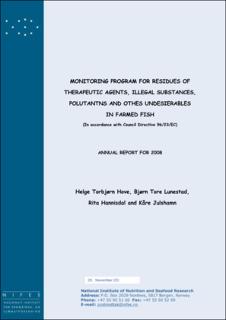| dc.description.abstract | With the increasing production volume of farmed fish in Norway the marine part of the EU Directive 96/23/EC monitoring program is now extensive. This report is based on a total of 9066 fish and 9785 analytical determinations. Like in the report for last year, all sums and mean values found in the tables are calculated according to the "upper bound-LOQ" principle (UBLOQ): the value of the relevant LOQ is substituted in the calculation for all values below the LOQ value. Individual values are still
reported as “<LOQ”, less than the LOQ. UBLOQ calculations give a "worst case" figure that is a good basis for contaminants risk assessment. As a result of the UB calculation the sums, and mean values in this report will be systematically higher than in the reports prior to the 2007 report. The group-A samples are intended for analysis of drugs that are banned from use in food producing animals. For that reason these samples are collected by official inspectors on the farm location with no prior notification. Samples for group-A determinations are taken in all growth stages of the fish and should be representative
for the fish in production. The group-B samples are analyzed for compounds for which an upper limit is established, or for compounds with a mandatory withdrawal period from medication or for compounds that for other reasons are monitored. The group B samples are taken from fish in the slaughterhouses or the packing plants. These samples should be representative for the commercially available Norwegian farmed
fish. No detectable residues of the pharmacologically active agents in group A were found.
For the veterinary drugs in group B, nine out of 56 examined samples were found to contain emamectin benzoate. The highest concentration found in one individual sample was 9.1 µg/kg wet weight (w.w.). The present MRL for this agent is 100 µg/kg. For all other therapeutic agents in group B (antibacterials, anthelmintics, other sea lice agents and dyes), no residues were detected. The mycotoxin ochratoxine A was not detected in any of the 35 pooled samples made from 175 individual fish.
The persistent organic pollutants (POPs) have been part of this program for years. The number of compounds and compound classes are increased in this period. The levels found for the dioxins (PCDDs and PCDFs), DLPCBs, PCB-7 and the organic pesticides were similar to the results from this program for the years 2003 to 2007, and also to the corresponding values found in the online database: "Seafood data" (www.nifes.no).
The brominated flame retardant compounds and compound classes PBDE, HBCD and TBBP-A are included in the program. The PBDEs are structurally similar to the PCBs. But the sum PBDE-7 amount to less than 20% of the value for the sum PCB-7. Their 48 48 toxicity is also lower. All samples analyzed for TBBPA had levels below 1.0 µg/kg w.w. Total HBCD has the UB-mean of 0.5 and a maximum value of 0.6 µg/kg w.w. In the class of heavy metals over the years since 2002 a total of 1030 samples have
been analysed. For all these samples the maximum value for arsenic was 6.3 mg/kg w.w. The concentrations of cadmium were in all these samples less than or equal to 0.01 mg/kg w.w. accept for one single sample that, within the analytical uncertainty, was found at the value of the EU upper limit. The levels of mercury were below or equal to 0.23 mg/kg w.w. The levels of lead were less than or equal to 0.1 mg/kg w.w. The EU upper limits for cadmium, mercury and lead are 0.05, 0.5 and 0.3 mg/kg w.w.
respectively. Thus, based on 1030 samples made from more than four thousand fish we conclude that no incompliant sample was found. And that Norwegian farmed fish are well below the EU upper concentration limits for the heavy metals. The synthetic antioxidants are legal additives to fish feed. It can be concluded from the results that there is a significant transfer of synthetic antioxidants from the feed to the
fish fillets. For BHT, the results also show that there has been a steady increase in the levels for the last few years. A national upper limit in Japan is now exceeded by fish in the present data set. For BHT about 10% of the fillet samples exceed the Japanese limit while the year before 3% exceeded the limit. A national upper limit for ethoxyquine in some German states is exceeded by more than 75% of the samples in 2008, while the year before more than 50% exceeded the limit. Due to the observed increasing trend for these compounds, they should be given a high priority in the monitoring in the next years. Ten PFC compounds (perfluorinated organic compounds) are included in the program. This class is characterized by a low acute toxicity and very high degree of persistence in the environment. For all the ten compounds the levels in the nine samples were less than their LOQ values. This confirms that the levels of PFCs are low in Norwegian farmed fish. Thirteen PAH compounds are included in the program. This class is of interest because some of the compounds are carcinogenic. The most potent carcinogenic of the analysed compounds is benzo[A] pyrene (BaP). This compound is the only one with an established upper limit. The concentrations of BaP are below the limit and below the LOQ in all of the twenty samples analysed in 2008. In the majority of the samples only fluorene and phenantrene are found in measurable concentrations. These are far less potent health hazards than BaP. | en_US |

